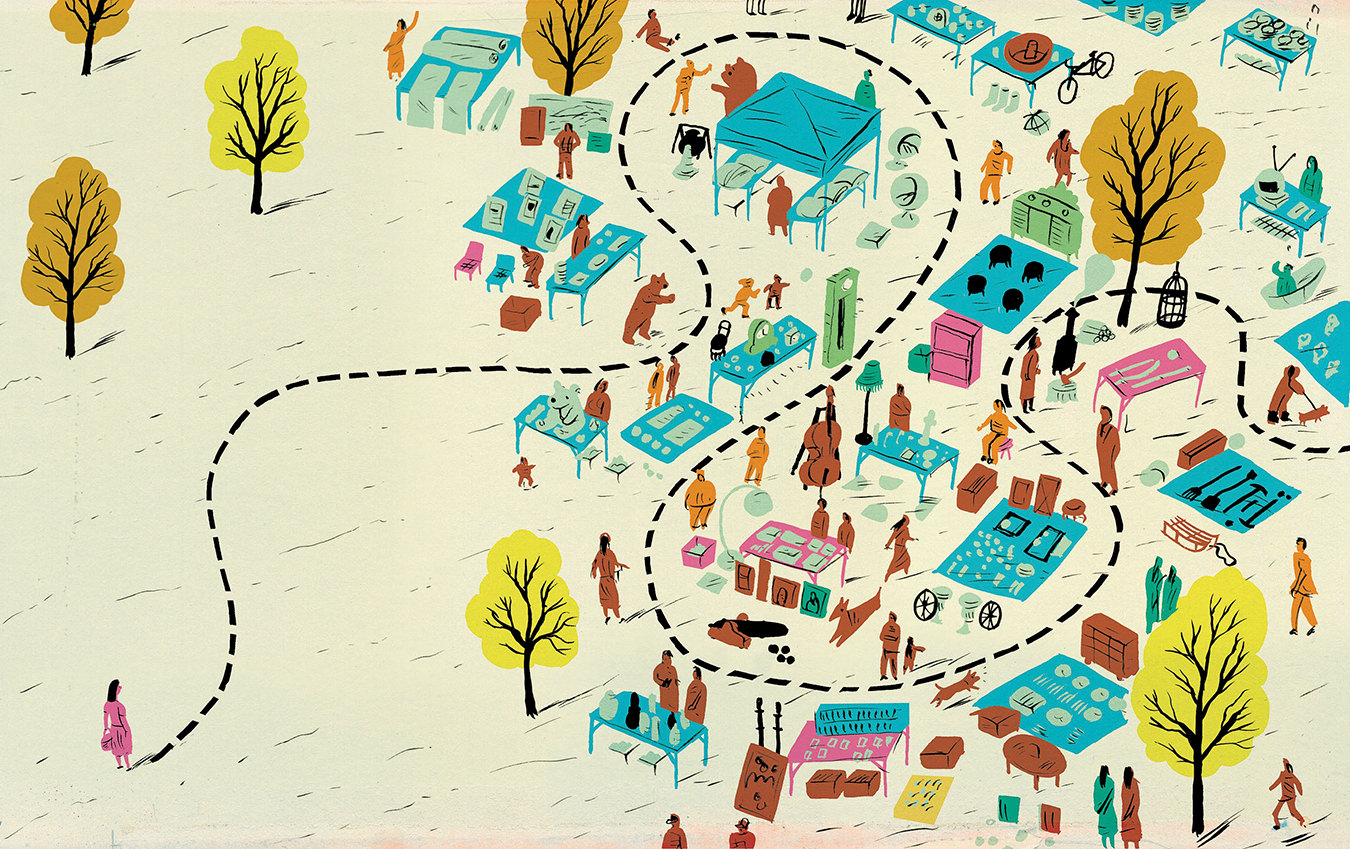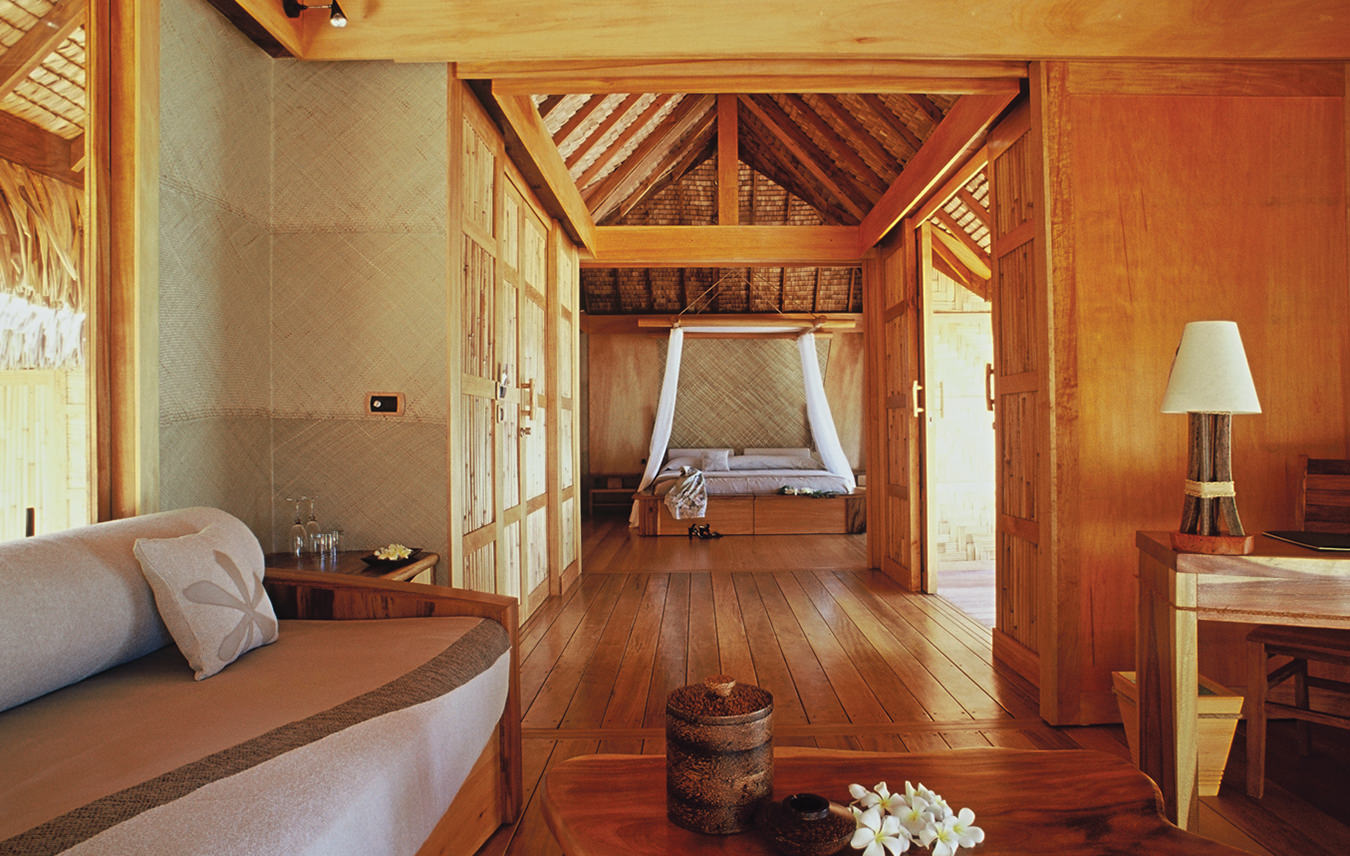The Flea Markets of France
Antiques de résistance.

Illustration by Paul Blow.
The last time you saw that postcard you wrote was when it disappeared into a mailbox slot in Marrakesh or Brontë country—and now, back home weeks later, it reappears, pinned to a friend’s corkboard. I experience that kind of feeling, as if I’ve suddenly found myself in a parallel universe, when I spot an object I own that has seemingly been teleported from a shelf in my bedroom into the biggest flea market in Paris.
My first thought is an indignant one: “What’s that doing there? It’s mine.” I know every detail of this little tin box, with its hinged lid and the whimsical gnomes printed on the top and all four sides. Originally meant to hold sewing machine bobbins, the small tin in front of me on the antiques stall is nested in an organized clutter of brass paper knives, delicate lace collars, seed packet labels, and other vintage ephemera; I turn it over and the price is handwritten on a tiny label on its underside.
I had ridden the metro to the Porte de Clignancourt station early that Sunday morning, making my way through a firewall of sellers of old jeans, baseball shirts, and Indian gauze and into the thick of the Marché aux Puces de Saint-Ouen. Ornate clocks, superb escritoires, handmade wooden dolls, rare lead soldiers. Six hectares, 2,000 vendors. If you cannot find it here, it probably doesn’t exist, so I shouldn’t have been surprised to come upon the same small tin box decorated with fairy-tale creatures that I use to corral bits and pieces of costume jewellery, except that I was somewhat surprised at its price. The Parisian dealer wanted €80; I had paid €3. The difference was that I had managed to snare my find at the bottom of the French pre-owned food chain which eventually ends on a carefully curated stall in Paris. Like any social hierarchy, this one starts at street level.
If you plan to include antiques hunting in a visit to France, you can begin at the vide-grenier—literally an “attic sale” which is the Gallic version of a community yard sale where you buy something from its original owner or a descendant.
It strikes me, looking around our maison in France where my husband and I live, that barring the inevitable IKEA shelves, almost everything in it has passed through others’ hands. The house is ancienne and it seems impolite to completely kit it out with brand new furnishings. Better to gradually fill it with furniture that it might have accumulated naturally over the decades.
At least that’s what I tell myself. The truth is that I’ve always preferred the faded and patinated to the brand new and shiny. It began with impoverished days in Montreal, bonding with friends over giant tins of the paint stripper we slathered on to furniture to uncover the 19th-century pine that would eventually emerge from undercoats and enamel, and building bookshelves out of silvery, weathered barn boards.
When we bought our first house in France, someone pointed us in the direction of a vide-grenier. I recognized that a house of only 70 square metres demanded small furniture that earned its keep, and made my first purchase, a sewing table that concertinaed out into three sets of drawers and did duty as a side table. Next came a dining table with a drawer so large that I’ve been told it may have come from a school. An afternoon of hard work, steel wool, and turpentine brought it down to the raw wood, to which I applied the first of many coats of beeswax polish. Very abbaye de Downton.
There was no room for the purely decorative, which is possibly why I began collecting tins. Tins hold things. To backtrack, during the mid-century years, in an “aha” moment, French food manufacturers realized that they could draw customer loyalty by packaging their merchandise in printed tins that were part of a set which, once emptied, would hold sucre, thé, café, and so on. Only rarely did the set manage to stay together, and like a nomadic family, it dispersed and eventually showed up on second-hand stalls. I own part of a set showing behatted ladies from various regions. Another example has a seductive, head-wrapped temptress from the 1920s. I’ve now amassed so many that they stand in tottering columns on either side of the kitchen window, each one a Proustian madeleine that slingshots me back to the Sunday (vide-grenier are usually held on Sundays) when I bought it.
At the vide-grenier, the village main street has been blocked off by barriers, and sellers have set up their trestle tables. Vendors pay by the metre, and the law stipulates that they can only sell twice a year in their own community. Get there early, give all the stalls a quick once-over, and if you spot anything you like, start the bargaining process with a gentle, “Would you take X euros?” Vitally, never tell yourself that that art deco figurine will be there on your second circuit.
As an experienced vide-grenieriste, I can case the joint as I walk toward the first cluster of tables. Predominantly pink stalls indicate petite Nicole has tired of her Barbie collection, but not always. (Rooting through a box of children’s books—“There are some English books in there,” the vendor told me—I recently came upon an 1897 Baedeker guide in pristine condition.) And never assume that a lack of tags means hefty prices; it’s more likely that the seller just couldn’t be bothered.
Because this is France, there’s always a buvette, a snack bar, staffed by volunteers, offering merguez or slices of pork belly sizzled over charcoal and slapped in a slashed baguette with pump-operated containers of ketchup, mayonnaise, and mustard to add at will. There are the obligatory frites, beer, chilled rosé, vin rouge, coffee, and the usual soft drinks. All you have to do is find a convenient stone wall to perch on.
This is not to say that you can’t build a solid Sunday lunch into your plans. The annual vide-grenier in the village of Fanjeaux (known as the home of St. Dominic, if you want culture with your hunting) is held on what is usually a sweltering August day. We park the car, don straw hats, idle from one shady spot to another but still, because it’s become a tradition, adjourn at noon to La Table Cathare for a full-on cassoulet. A time out isn’t a bad idea. At some point, you need to pause to reflect, to wonder if you should pay the asking price for that art nouveau candlestick, or how easy it would be to pack those 1905 fashion magazines in your suitcase, or just how many fin de siècle postcards with spidery brown writing a person needs, or whether, in my case, I really should buy another tin. And then I start to think about the kitchen shelf it stood on, envisage the aproned grand-mère tipping flour from it into a large earthenware bowl. Speculating on their past is surely part of the charm of owning vintage things.
Along with the big Porte de Clignancourt market in the north, Paris also has a lesser-known one in the south, the Marché aux Puces de la Porte de Vanves, located almost at the peripherique, the hellishly busy ring road that, if you’re a real Parisian, defines who is one and who isn’t. Getting there is as simple as taking the metro to the Porte de Vanves stop and following the crowds.
Once, I unearthed a deeply yellow pair of hand-crocheted curtains, which I like to think once hung in a café, stained with the gossiped sins of the last 50 years whispered by pastis-swigging locals puffing away on unfiltered Gauloises.
Once, just as this market was packing up, I dug my way through a heap of old textiles and unearthed a deeply yellow pair of hand-crocheted curtains, which I like to think once hung in a café, stained with the gossiped sins of the last 50 years whispered by pastis-swigging locals puffing away on unfiltered Gauloises. I bought them from the snappish Madame, wrapping them in plastic to stop the smell impregnating everything in my luggage, took them home, and threw them in the washing machine. It took four cycles to restore them to anything like their original crisp whiteness.
Often, at vide-greniers and marchés aux puces, you come across a stall of nothing but whites, so bleached and dazzling you can hardly look at them in the strong sunlight of a July day in le Midi. These are motherlodes of real linen sheets, or sheets labelled as “Métis”, a linen and cotton blend. Both fabrics get softer with use, and as long as you can live with rumpled linen (and, personally, I can, provided it’s lavender-scented), these trousseau-worthy linens go as easily in the washer and dryer as modern sheets do and, a plus, usually have thickly embroidered white-on-white monograms. On a practical note, vintage sheets are often exceptionally long, as they were designed to tuck under and around those firm sausage-shaped bolsters that used to be a feature of French beds. If you do buy linen, be warned that sheets rarely stretch beyond a double bed (or lit matrimoniale) in width, and pillow cases are normally square, not rectangular.
One step up the social ladder from the vide-grenier is the dépôt-vente, a consignment store that saves you the bother of selling something yourself. Over the past 10 years, our local one has turned up a 1930s glass lampshade embellished with scenes from a mythical Egypt, and several wooden cow collars.
Cow collars? Part of the fascination of wandering around a dépôt-vente in our part of France, the Ariège in the deep south, is the window it offers into a time not long ago, when yoked oxen pulled ploughs, farmers drove carts, and in the winters, you went to a bed prewarmed by a skeletal wooden device that held a metal box full of hot ashes.
Sometimes what I’ve bought here has concealed a secret. Covers for cushions were often simply placed over the old one. Freckled with age, a certificate of excellence in agriculture, complete with ornately curlicued lettering and illustrations of winsome milkmaids and lusty farmer lads, had a chocolate-box lid portrait behind it—suitable for framing.
All these discoveries are put to use, daily in the case of the plates in our kitchen that were manufactured by the Sarreguemines company. Eating duck confit or a daube, the meat ringed by flowers printed in the inky blue of the veins in a chunk of roquefort, I wonder what other tables these plates have been on, and also question if the smaller plates of times gone by were a natural cause of smaller waistlines.
I’ve seen our local dépôt-vente owner browsing at vide-greniers, and spotted antiques dealers from the United Kingdom cruising the cluttered aisles of the dépôt-vente. From there, those plates and linens and armoires and tins with gnomes on them may move to a brocante, which is pitched somewhat higher on the second-hand social ladder. And from there, it’s only a short leap to a fine-antiques stall in Paris.








